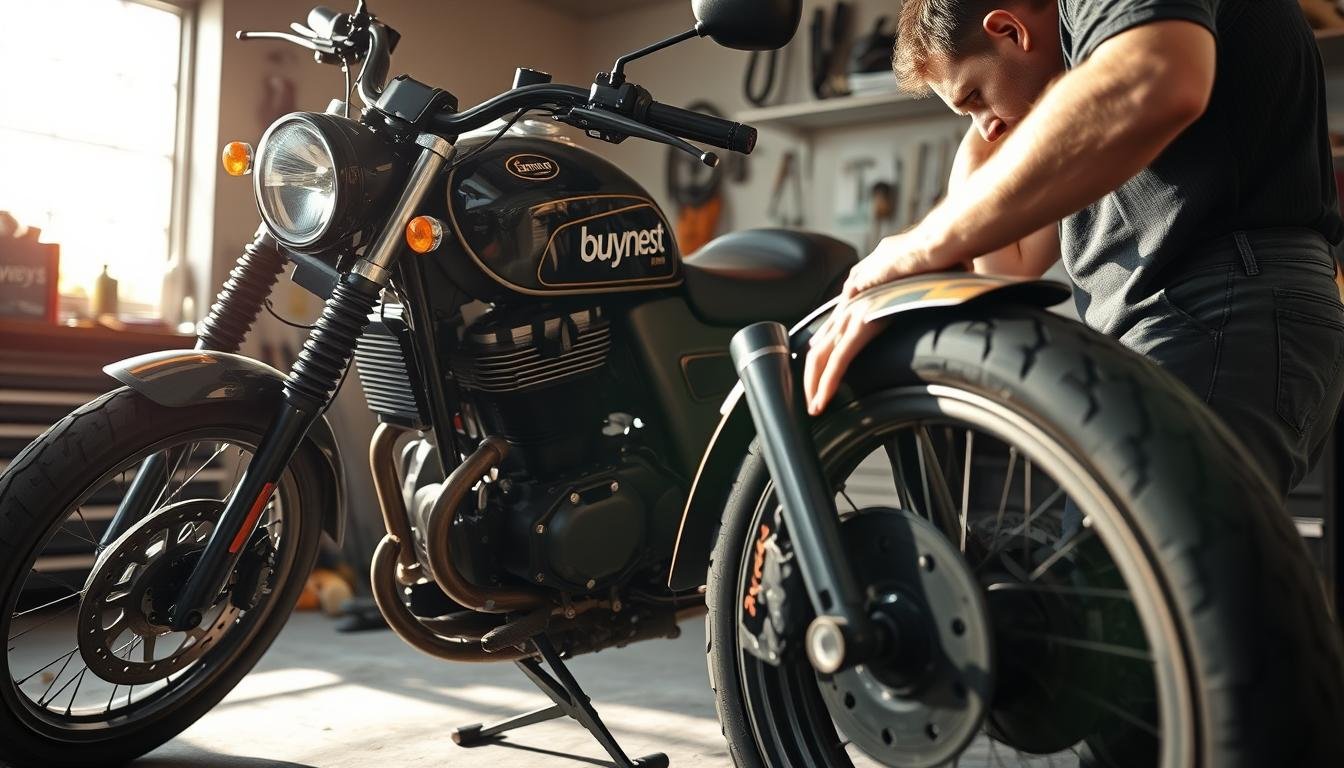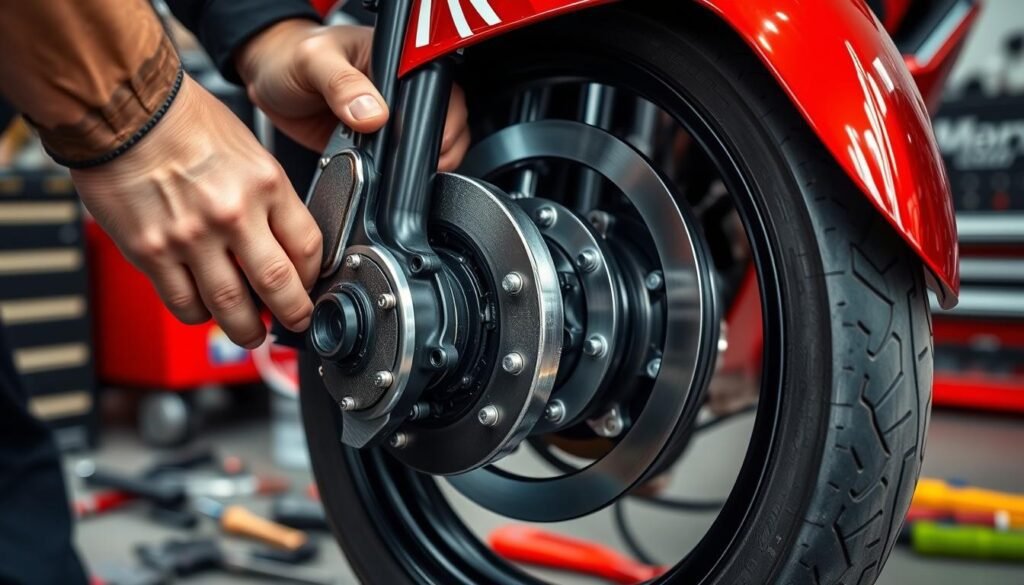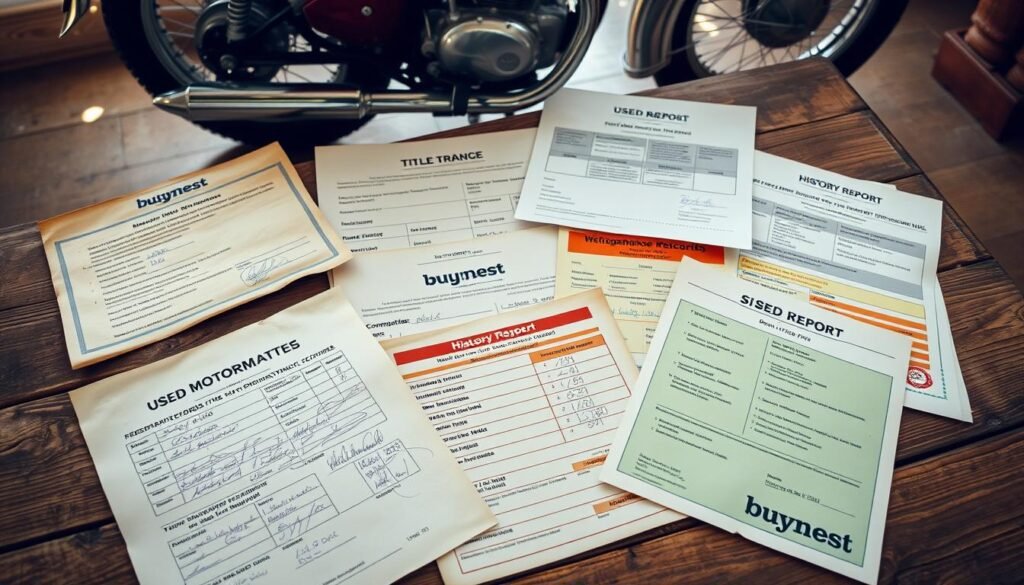
How to Inspect a Used Motorcycle Before Buying
Buying a used motorcycle can be thrilling but also a bit scary, especially for new buyers. It’s important to check the bike carefully before you buy it. This guide will help you inspect a used motorcycle, covering important areas like looks, engine, and brakes.
It also talks about checking the bike’s history and documents. This ensures you’re getting a safe and reliable ride.
Key Takeaways
- Inspect the overall appearance and cosmetic condition of the motorcycle to check for signs of damage or abuse.
- Examine the engine and exhaust system for any issues, such as weak mounts, corrosion, or leaks.
- Evaluate the transmission and clutch operation to ensure smooth engagement and release.
- Test the brakes and suspension to ensure proper functioning and safety.
- Verify the motorcycle’s documentation and history to ensure authenticity and avoid potential issues.
Evaluating the Overall Appearance
When checking out a used motorcycle, start by looking at its overall look. This means checking the used motorcycle appearance, motorcycle cosmetic inspection, and spotting any signs of damage or previous accidents or crashes. By carefully assessing the motorcycle’s condition, you can learn a lot about its past and any possible problems.
Examining Cosmetic Condition
First, inspect the motorcycle’s body and frame for any dents, scratches, or rust. Check the paintwork closely, as uneven or mismatched paint can hint at previous repairs or accidents. Also, look for any missing or mismatched bolts and fasteners, which might suggest hasty repairs or parts replacements. Check the plastic fairings for any broken or damaged tabs, as these are common areas to fail after a crash.
Checking for Signs of Damage
Next, examine the motorcycle’s frame for any signs of cracks or bends. These can be serious signs of structural damage. Also, look for any signs of previous collisions, such as deep parallel scratches, non-standard paint jobs, dents in the gas tank, or twisted front forks. These signs can show if the motorcycle has been in a crash and might need more inspections or repairs.
“A general rule of thumb mentioned is that most dealerships charge around $50/hour for labor, potentially higher for European marques like Ducati, BMW, and Triumph. This highlights the average labor cost for repairs on used motorcycles when purchasing from dealerships.”
- Inspect the motorcycle’s body and frame for any dents, scratches, or rust.
- Examine the condition of the paintwork, looking for uneven or mismatched paint that could indicate previous repairs or accidents.
- Check for any missing or mismatched bolts and fasteners, which could suggest hasty repairs or parts replacements.
- Inspect the plastic fairings for any broken or damaged tabs, a common issue after a crash.
- Look for signs of structural damage, such as cracks or bends in the motorcycle’s frame.
- Identify any indicators of previous collisions, including deep parallel scratches, non-standard paint jobs, dents in the gas tank, or twisted front forks.
By thoroughlyevaluating the overall appearanceandchecking for signs of damageon a used motorcycle, you can gain valuable insights into its history and condition. This can help you make a smart buying decision.
inspect used motorcycle
Inspecting the Engine and Exhaust
When checking a used motorcycle, it’s key to look at the engine and exhaust closely. First, check for oil leaks or engine damage. Look for any signs of leaks around the gaskets and seals. Also, make sure the exhaust pipes are in good shape, without rust or damage.
Next, start the engine and listen for odd sounds. Sounds like knocking or ticking might mean there’s a problem inside. Also, watch the exhaust smoke color. Blue smoke means oil is burning, and white smoke could mean coolant is leaking.
Evaluating Transmission and Clutch
Try shifting gears with the clutch lever, either on a center stand or during a test ride. The clutch should move smoothly without slipping or sticking. Also, the transmission should shift gears without any grinding sounds. These steps can help spot any transmission and clutch problems that might cost a lot to fix.
| Inspection Area | What to Look For |
|---|---|
| Engine | Oil leaks, damage, unusual sounds |
| Exhaust | Rust, damage, exhaust smoke color |
| Transmission | Smooth gear shifting, no grinding noises |
| Clutch | Smooth engagement, no slipping or sticking |
By carefully inspecting the engine, exhaust, transmission, and clutch, you can find any signs of engine issues or transmission and clutch problems. This can help you know if the used motorcycle is reliable. A detailed check will help you make a smart choice and avoid unexpected costs later.
Testing Key Components
Before buying a used motorcycle, it’s key to check important parts. Look at the brakes, suspension, tires, and wheels. Make sure they’re in good shape and work right.
Checking Brakes and Suspension
First, check the brake pads for thickness and even wear. The brake discs should be smooth and even. Also, check the brake fluid levels in both reservoirs. The fluid should be clear and not dirty.
Next, look at the suspension. Check the front forks and rear shocks for leaks or damage. Push down on the handlebars and rear to see if it moves smoothly without noise.
Inspecting Tires and Wheels
Examine the tires for wear, cracks, or punctures. The tread should be at least 1/16 inch deep. There should be no bald spots or uneven wear.
Also, check the wheels for dents, cracks, or bends. These could affect the bike’s handling and safety. Look for any damage or excessive wear that could harm the wheel’s integrity.
| Component | Inspection Criteria | Recommended Condition |
|---|---|---|
| Brakes | Brake pads, brake discs (rotors), brake fluid | Sufficient pad thickness, no grooves or warping in discs, clear and clean brake fluid |
| Suspension | Front forks, rear shocks | No leaks or damage, smooth compression and rebound |
| Tires | Tread depth, wear patterns, pressure | Minimum 1/16 inch tread depth, no uneven wear, proper tire pressure |
| Wheels | Condition of rims | No dents, cracks, or bends |
By inspecting the brakes, suspension, tires, and wheels well, you can spot any problems. This is vital to make sure the motorcycle is safe and ready to ride.

Verifying Documentation and History
When buying a used motorcycle, checking the documentation and history is key. First, make sure the Vehicle Identification Number (VIN) on the bike matches the VIN on the title and other papers. You can find the VIN on the steering neck or near the engine.
With the VIN, you can get a vehicle history report. This report shows if the bike was in accidents, stolen, or recalled. It also tells you about the bike’s past owners and maintenance, helping you understand its care.
Ask the seller about the bike’s past and maintenance. Look for signs of good care or neglect. A well-kept bike with a clear history is likely a good buy.
| Key Documentation to Verify | Importance |
|---|---|
| Vehicle Identification Number (VIN) | Ensures the motorcycle’s identity matches the documents |
| Vehicle History Report | Reveals past issues, accidents, and maintenance history |
| Ownership and Maintenance History | Provides insight into how the motorcycle has been cared for |
By thoroughly checking the used motorcycle’s documentation and history, you can make a smart choice. This ensures you get a reliable and safe bike.

Conclusion
Checking a used motorcycle before buying is key to getting a good and safe bike. Follow this guide to spot issues and judge the bike’s quality. Take your time, use a detailed checklist, and listen to your gut feeling.
Looking for a used motorcycle can be a smart move. But, make sure to check the bike’s value, test ride it, and have a mechanic look at the engine and transmission. Also, check the paperwork and look for any physical damage.
Buying a used motorcycle can save you money. But, it’s important to inspect it well before you buy. By carefully checking the bike’s condition, history, and if it fits your needs, you’ll know you’re making a good choice. This way, you’ll enjoy many years of riding on the open road.
FAQ
What are the key areas to focus on when inspecting a used motorcycle?
When checking a used motorcycle, start with the overall look. Then, inspect the engine and exhaust. Next, test the transmission and clutch.
Don’t forget to check the brakes and suspension. Finally, make sure the documentation and history are correct.
How should I inspect the overall appearance of the used motorcycle?
Look for dents, scratches, or rust on the body and frame. Check the paintwork’s condition. Also, inspect the frame for cracks or bends.
Make sure all bolts and fasteners are there and match. Check the plastic fairings for damage.
What should I look for when inspecting the engine and exhaust?
Check for oil leaks or damage on the engine. Look at the exhaust pipes’ condition. Start the engine to listen for unusual sounds.
Check the exhaust smoke color. Blue smoke means oil burning, and white smoke could be coolant leaks.
How do I evaluate the transmission and clutch?
Test the clutch and shifting through all gears. The clutch should engage smoothly. The transmission should shift without grinding noises.
What should I check when inspecting the brakes and suspension?
Check the brake pads and discs for damage. Make sure the brake fluid is clear and at the right level.
Inspect the suspension for leaks. Test it by pushing down on the handlebars and rear end.
How do I verify the documentation and history of the used motorcycle?
Make sure the VIN on the motorcycle matches the VIN on the title and documents. Use the VIN to get a vehicle history report.
This report can show accidents, thefts, recalls, and maintenance records.













